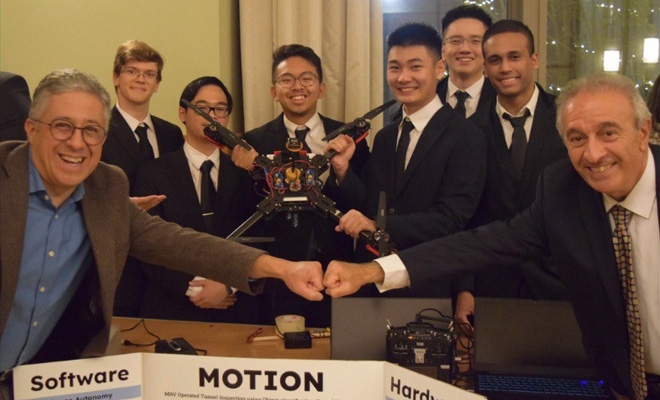Project MOTION: MAV Operated Tunnel Inspection Using Object-classification Neural Networks

MOTION: MAV Operated Tunnel Inspection using Object-classification Neural Networks
Overview
Welcome to the MOTION project, an innovative solution for inspecting tunnel infrastructure using a small Unmanned Aerial System (UAS). This project leverages Region-based Convolutional Neural Networks (R-CNN), Simultaneous Localization and Mapping (SLAM), and an integrated sensor suite to detect and evaluate hazardous fractures within tunnel walls. The MOTION project won first place in the annual Northeastern ECE capstone competition, showcasing its effectiveness and innovation.
Project Description
The MOTION project addresses the critical need for safe and efficient tunnel inspections. Recent infrastructure collapses, such as the MBTA�s Government Center collapse, have highlighted the importance of reliable inspection methods. Our solution uses advanced computer vision and localization techniques to autonomously navigate and inspect tunnels, providing detailed analysis for civil engineers.
Key Features
- R-CNN for Crack Detection: Utilizes Mask R-CNN to accurately detect and classify cracks in tunnel walls.
- SLAM for Navigation: Implements SLAM algorithms to navigate GPS-denied environments, ensuring precise localization.
- Integrated Sensor Suite: Equipped with various sensors, including RGB-D cameras, LEDs, and Hall Effect sensors, to gather comprehensive data on tunnel conditions.
Methodology
Computer Vision with Mask R-CNN
Mask R-CNN is used for instance segmentation, allowing the system to detect and classify multiple objects within each frame. The model was trained on the Concrete Crack Conglomerate Dataset from Virginia Tech and the National Science Foundation, ensuring accurate detection of surface-level cracks.
UAV System
The UAV, named FROG, is a 14� propeller-class quadcopter running PX4 flight software. It is equipped with a Jetson Nano mission computer and a Realsense D435i RGB-D camera for navigation. Additional hardware includes a T265 tracking camera and high-powered LEDs for low-light conditions.
Simulation
To develop and test autonomous capabilities, we used PX4 firmware simulation and the Gazebo physics simulation environment. This allowed us to verify our algorithms and ensure safe operation before deploying the system in real tunnels.
SLAM Implementation
We explored two implementations of SLAM:
- STELLA ORB V2: Generates accurate 3D maps using features and landmarks.
- RTAB MAP SLAM: Creates detailed 2D point cloud maps for visual interpretation.
Sensor Suite
- On-board LEDs: Provide illumination for the RGB-D camera in low-light conditions.
- Hall Effect Sensor: Detects magnetic fields as a proxy for subsurface crack detection.
Results
First Place at Northeastern ECE Capstone Competition

Integration Tests
We conducted tests at Franklin Park and Clinton Tunnel to validate the functionality of our system. These tests confirmed the successful operation of all components, including SLAM algorithms and sensor integration.
Computer Vision Tests
Our Mask R-CNN model achieved a validation accuracy of 96%, significantly higher than the 82.9% accuracy of human labeling. The model's ability to generate masks for detected cracks improves the explainability and reliability of the results.
SLAM Tests
Our SLAM implementation was tested in both simulated and real environments. The STELLA ORB V2 SLAM provided accurate localization using infrared depth data, and RTAB MAP SLAM generated visually appealing maps for easy interpretation.
Hardware Tests
We validated the performance of our sensor suite and UAV system in the Clinton Tunnel, ensuring reliable operation in low-light and GPS-denied environments. The Hall Effect Sensor successfully detected subsurface cracks, providing valuable data for further analysis.
Future Work
Sensor Suite Expansion
- IR Thermal Camera: For detecting subsurface cracks through thermal radiation.
- RGB-D Camera: To provide depth information for 3D modeling of cracks.
- Ground Penetrating Radar: For detecting buried structures and subsurface features.
Data Pipelining
We plan to integrate cloud-based post-processing and visualization tools to handle the large amounts of data collected during inspections. This will allow civil engineers to efficiently analyze and interpret the results.
Conclusion
The MOTION project demonstrates the potential of combining UAVs, advanced computer vision, and SLAM techniques for tunnel inspection. By providing accurate and detailed analysis, our system enhances the safety and reliability of infrastructure inspections. The first-place capstone win highlights the innovation and effectiveness of our approach.


